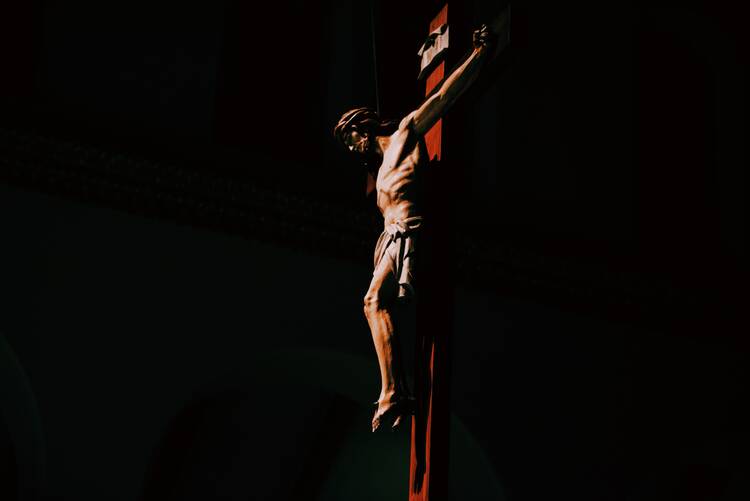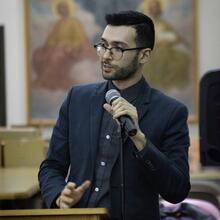“‘God is dead’ is the most misquoted and abused of Nietzsche’s one-liners,” commented Anna Khachiyan in a recent episode on the “Red Scare” podcast. “And I think,” replied Dasha Nekrasova, her co-host, “as Christians we should actually be grateful to Nietzsche.”
The late Pope Benedict XVI can be counted among the Christian theologians who acknowledge their indebtedness to the father of postmodern thought. Friedrich Nietzsche’s controversial pronouncement from The Gay Science was the subject of exploration in several of then-Cardinal Ratzinger’s reflections on Holy Saturday. When Nietzsche declares the death of God, he means that the cultural framework that once “propped up” Christian faith and morality has eroded, thus making belief in God irrelevant to life in modern Europe.
Holy Saturday held a particular significance for Ratzinger, as he was born and baptized on that very day in 1927.
In 1998, Ratzinger’s writings on Holy Saturday, were compiled along with paintings and commentary by the American artist William Congdon in a collection entitled The Sabbath of History. Though Congdon—a convert to Catholicism commonly associated with the Abstract Expressionist movement—never met Ratzinger, both men were deeply attracted to and perplexed by the mysterious events of Holy Saturday.
In the book, Ratzinger describes how Holy Saturday held a particular significance for him, as he was born and baptized on that very day in 1927. His life “from the beginning seemed oriented to this strange chiaroscuro of pain and hope, of divine hiddenness and presence” that he associated with Holy Saturday. It is a day that hangs suspended between the “visible humanity” of Good Friday and the “radiant divinity” of Easter Sunday.
On Holy Saturday, Christ’s body, brutalized on Good Friday, lay in the tomb. We remember on this day the mysterious assertion of the Apostles’ Creed: that Christ “descendit ad infernos,” he descended into hell. The church tells us, according to an ancient homily, that in hell, Jesus freed “the prisoner Adam and his fellow prisoner Eve from their pains,” seeking them out like “lost sheep.”
Jesus descends into hell and frees “the prisoner Adam and his fellow prisoner Eve from their pains.”
Ratzinger is cautious in his interpretation of the word “hell,” preferring to leave it enshrouded in mystery. He suggests that infernos in this case may be better understood in the context of the Hebrew word sheol or the Greek Homeric hades, referring to an ultimate abyss characterized by “ultimate solitude,” the “loss of all communication,” and where “love does not penetrate.”
And yet, “God’s dying in Jesus Christ is at the same time expression of his radical solidarity with us,” Ratzinger writes. “The darkest mystery of our faith is simultaneously the brightest sign of hope that is without limits.” God’s silence on Holy Saturday, the feeling that he is not responding to our prayers, is not a cause to mourn his definitive death. Rather it marks a period where we eagerly await his waking up from a “divine sleep,” as Ratzinger puts it, comparing it to the time Christ slept on the boat during a tempest.
Ratzinger notes that Nietzsche’s proclamation about God’s death “was taken almost literally from the language of Christian tradition.” Rather than attempting to refute Nietzsche’s claim, Ratzinger provokes believers to allow their consciences to be pricked by it and to call into question the foundations of their beliefs.
“God’s dying in Jesus Christ is at the same time expression of his radical solidarity with us.”
“We killed him,” Ratzinger continues, “by enclosing him in antiquated ways of thinking, by banishing him to a piety void of reality, which becomes more and more a devotional slogan or archaeological curiosity.” We reduce God to a set of rituals and rules to follow, failing to allow ourselves to fully feel our need for his love and embrace him in all of his greatness and mystery. When believers live their faith lukewarmly and lose sight of what lies at the root of their beliefs, how can non-believers be convinced by their witness?
In The Sabbath of History, Ratzinger reminisces about attending the liturgy of Holy Saturday as a child when the windows of the church were completely covered with curtains. Though the “light from outside and above does not penetrate,” he knew that “the light was waiting.” Thus why he trusts that Holy Saturday is “filled with the mystery of hope.”
This image of the darkened church building was to Ratzinger symbolic of “the situation of our world” in the late 1960s. “Is not [Holy Saturday],” he asks, “in an uncanny way our day? Does our century not begin to become one large Holy Saturday,” he posits, “when an icy emptiness grows even in the hearts of the disciples?”
This image of the darkened church building was to Ratzinger symbolic of “the situation of our world” in the late 1960s.
In the time leading up to the Second Vatican Council, Ratzinger distinguished himself from those who held on tightly to past theological frameworks, as well as from those who were quick to do away with church tradition in the name of progress. With the dialectical style of a veteran scholar, he engaged with the abyss of doubt brought on by postmodern thought and the cultural revolution of the 1960s. He never compromised his convictions or obedience to the Church, but was not afraid of interrogating foundational questions about the faith and engaging in dialogue with non-believers.
“Precisely as a participant in the exigencies of our generation I felt called to give voice to the hope that in truth always lies especially near in the hour of silence and darkness,” he wrote. This method of responding to the times by wading through the darkness of doubt rather than addressing it from the “outside” marks the tone of his seminal 1968 text Introduction to Christianity.
Ratinzger’s willingness to wrestle with the contentions of philosophers like Nietzsche and Sartre made him an apt dialogue partner for non-believers like Jurgen Habermas, Julia Kristeva, and Mario Vargas Llosa. His daring reputation and postmodern flair even garnered him the title of the “campiest pope” by Italian cultural critic Fabio Cleto. Cleto is not the only one to have noticed the way Ratinzger’s taste for elaborate ritual and high culture resonates with the artistic sensibility known as “camp,” which is commonly associated with drag queens, pop stars, and fashion designers.
“The sufferings of the dying,” Congdon stated, “reveal to me my true identity.”
Ratzinger’s partner in The Sabbath of History, William Congdon, was deeply impacted by the sights of human suffering he encountered while deployed during World War II. “The sufferings of the dying,” he stated, “reveal to me my true identity.” His generous use of black paint on his canvases was a gesture of mourning but also of hope in the face of suffering. Light can only emerge from darkness—which in itself is a miraculous event.
Though Congdon’s conversion in 1959 raised eyebrows in the artistic community, his series of paintings of Christ crucified and in the tomb won acclaim from critics. These images were the “supreme subject” of his life, as the encounter with Christ made him “discover that His drama on the cross” was also his own. Congdon often referred to the “roads” we travel along as humans, littered with suffering and violence, as the “dying Body of Christ…trampled as if the traffic of ‘sin’ had crossed over it for or since all eternity, until the body, what was a body, became a stain.”
Congdon and Benedict are not the only figures in our times to have taken up the theme of Holy Saturday. For philosopher and activist Cornel West, Christianity “is not a belief in a Christ gladly crucified on Good Friday or risen from his tomb in time for church Easter Sunday, but a faith drawn from a recognition of the despair of the Saturday in between.” Holy Saturday represents Christ’s solidarity with the suffering of the oppressed, serving as a source of inspiration to Christians who, like West, engage in social activism.
For Cornel West, Holy Saturday represents Christ’s solidarity with the suffering of the oppressed.
For Slovenian philosopher (and self-proclaimed “atheist Christian”) Slavoj Zizek, the death of Christ has become a means to explore the moment “God became an atheist.” The debate presented between Zizek and Anglican theologian John Milbank in their 2009 book The Monstrosity of Christleaves us with the claim that either Christianity is the overflowing of divine love whose waves carries us into unity with God (“the paradox of Resurrection Sunday”); or it is the release from a distant, authoritarian deity thus giving us the chance to love others freely and without compulsion (“the dialectic of Holy Saturday”).
Either way, Zizek and Milbank demonstrate how the “monstrosity” of Christ’s passion presents the world with a form of love based on community and solidarity, as contrasted with western capitalist individualism.
On Holy Saturday, we hang suspended in that uncomfortably mysterious state between Christ’s death and resurrection; between our own daily sufferings and the hope that has been promised to us. We are provoked by God’s silence, his sleep. In such confounded moments—the moment of God’s death—it is easy for us to flee toward utter doubt and despair, or to numb ourselves with sentimental optimism.
But we can also invite him into our personal abyss, crying out with Ratzinger to the sleeping God: “Wake up, don’t let the darkness of Holy Saturday be endless, let a gleam of Easter also fall in our days…don’t let us sink into darkness; don’t let thy word be drowned in the banter of these days. Lord, help us, for without thee we would perish. Amen.”








